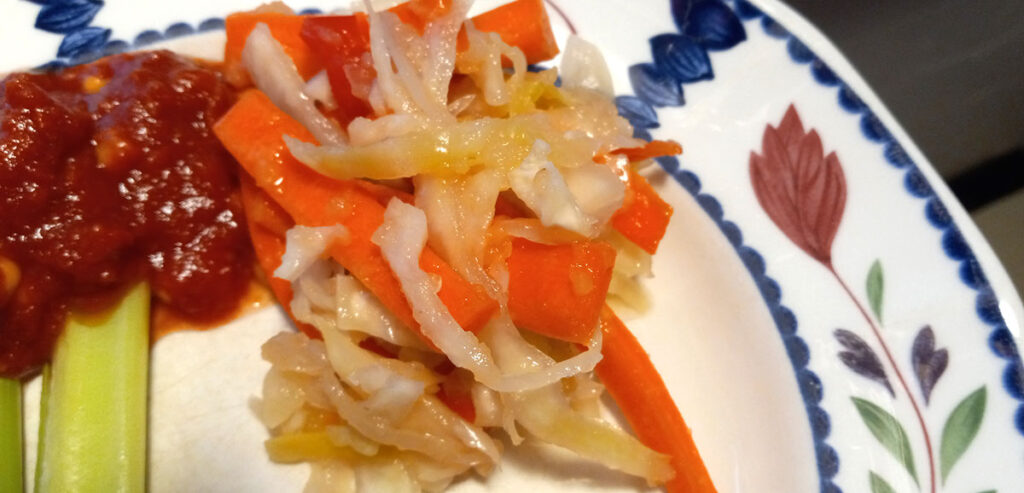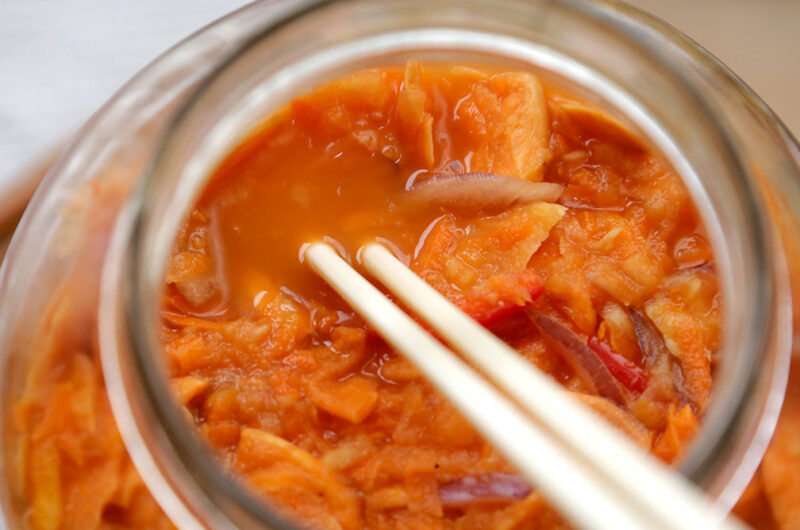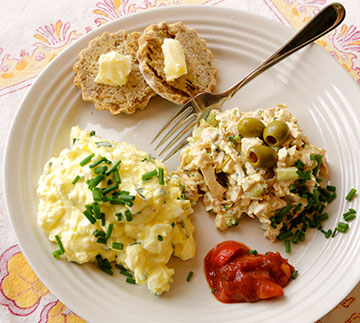Lacto-fermented vegetables help support gut health by increasing the presence of microbiota, beneficial bacteria, and probiotics in our digestive system. They are also a good source of prebiotics. They add a new dimension of taste and healthy benefits to your meals.
Try my easy recipes at the bottom of this page.
Update: Fermented vegetables are good for you in their raw state, but I just learned that even cooked, although some of the lactobacteria are killed in cooking, they turn into another beneficial post-biotic and they add so much flavor to stir-fries. I love adding some to soups just before serving; the crunchy carrots add a nice touch.
If you are not familiar with eating Lacto-fermented vegetables, the taste can be different. But it definitely grows on you and becomes something you crave. I like to use only enough salt to make the recipe work properly, and by adding other ingredients to the process, the taste is sweet-salty rather than overly sour. You can also add hot and spicy ingredients if this is the taste you are after. Kimchi is known for its heat, but various kinds are not so spicy at all. This means you will feel like eating them more often. We even have a spoonful with our breakfast most mornings.
Recently, we were away from home for several weeks and didn’t have any of our regular fermented condiments with our meals, and we could tell the difference in our digestion. Those of us on a gluten-free diet especially need to consider everything we can do for our gut health. Eating more fermented foods is great for everyone.
See below for instructions on how to make three tasty recipes.
People in many cultures have been preparing Lacto-fermented foods for hundreds of years to preserve them. They add a great condiment-style taste and are good for us, too.

See the recipes below.
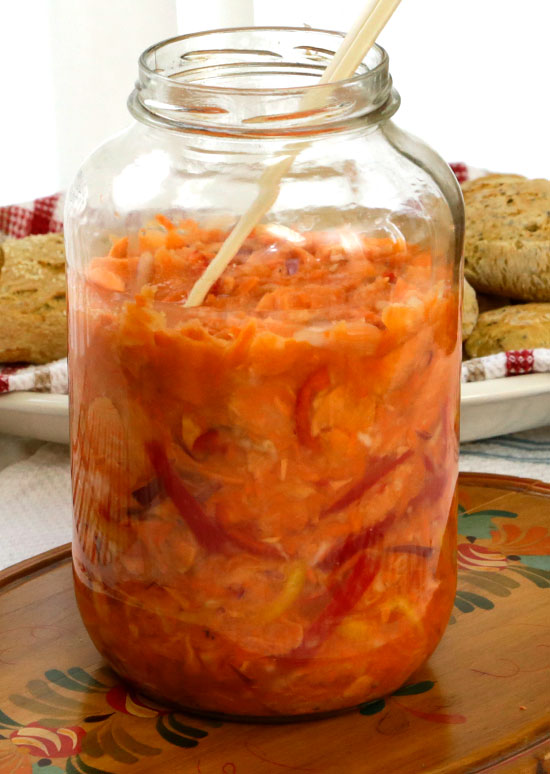
Sweet Potato Ferment
When you have some foods already prepped in your fridge, mealtimes are easier. In my fridge (shown above), I prepared three types of vegetable ferments ahead of time. Red Cabbage with Beets, Sauerkraut, and Sweet Potato ferments. I usually have only one prepared at a time and use it up before making another, but on this occasion, I had more. Adding just a little fermented vegetable to a meal makes eating some easy daily.
The Benefits of Adding Fermented Foods to Your Diet.
During the process of fermentation, the healthy flora and fauna in the fruits and vegetables, or the bacteria, break down the sugars and carbon dioxide, removing oxygen and making the food taste more acidic. During this process, the fruits and vegetables are preserved since the growth and multiplication of the lactic acid bacteria originally present in the food prevent the growth of other harmful microorganisms that would cause the food to go bad.
Carbohydrates are broken down into lactic acid and carbon dioxide, creating an acidic and low-oxygen environment. Eating these foods encourages good bacteria in your gut and a healthy balance of microorganisms.
Fermentation also helps many foods, such as carrots, remain crisp and juicy. That sounds good already, right?
Enjoy them for breakfast or brunch and set up your whole day for health.
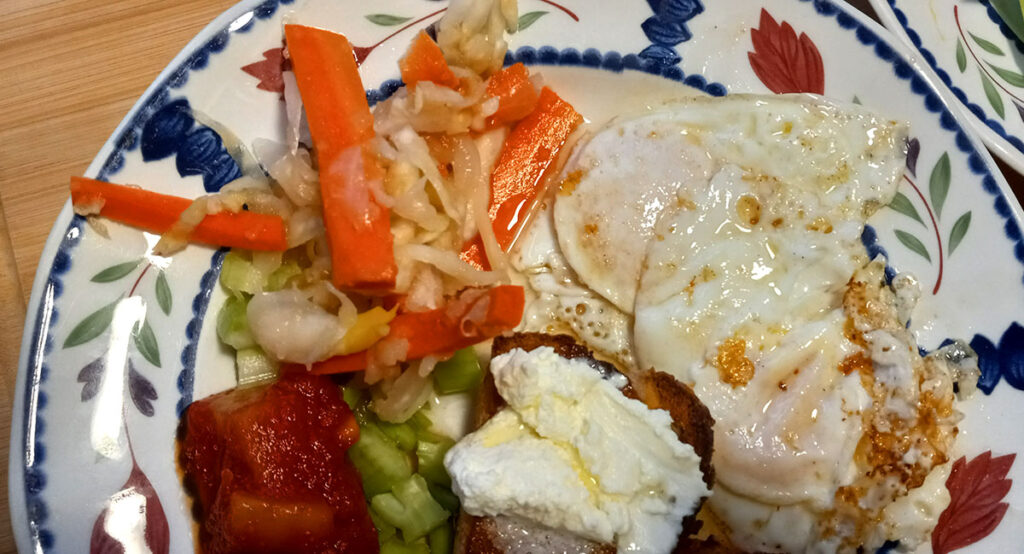
Gluten-Free Bread Recipes
https://glutenfreetrina.com/gluten-free-you-can-do-it-cookbook/
Preparing fermented vegetables and fruits also saves time since they can be stored for longer periods. The process provides a habitat that’s friendly to good bacteria and, when done correctly, discourages harmful organisms like fungi and molds from forming in the food. You can even incorporate a little fermented vegetable into stir-fries for added taste. Eliminate the salt that you might ordinarily add, as the salt in the ferment is usually enough.
Fermented Foods Can Help Reduce Wrinkles!
The benefits of fermented foods for skin health is well known. The Probiotics contained in these foods help reduce bacteria and yeast. Skin becomes clearer and acne or pimple breakouts are lessened. Fermented foods contain vitamins and minerals essential for skin. Lactic acid which is an alpha hydroxy acid (AHA) also has hydrating properties, which lessens the appearance of fine lines and wrinkles.
Did you know that fermentation can also improve the nutritional profile of many foods?
You may have heard that there is sometimes a difference when it comes to eating raw vs. cooked spinach.
They are both good for you, but cooked or steamed spinach can have some added benefits, depending on your nutritional needs. Cooked spinach contains three times more beta-carotene than raw spinach. Raw spinach contains oxalic acid, which blocks some of the absorption of iron and calcium. This means you absorb more iron and calcium from spinach that has been cooked.
Lacto-fermentation Methods and Stages
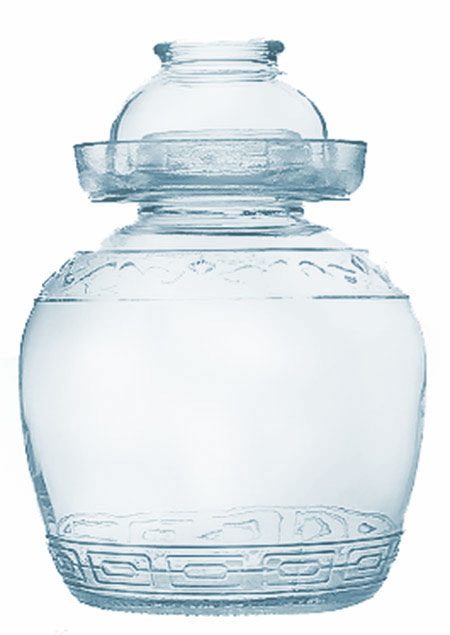
On the left is an example of a glass fermentation jar with a collar that you fill with water and then invert a smaller bowl on top.
It is worth getting one or two of these since they not only keep oxygen out of the fermentation but allow for the gasses to push up and escape.
A jar of this type can last for many years; it is easy to clean and has thicker glass for heavy use.
- There are three stages in the Fermentation Process:
- In the first stage, When a ferment is first started, some oxygen is still hidden between the ingredients. This bubbles up and out within a day or so. Keeping the jar covered is important, but keeping it completely tight to eliminate oxygen entering the jar is not as critical in later stages. At this point, it is more important to stir or push the ingredients down below the juice line.
- In the second stage, fermentation begins to be noticeable as you see more and more bubbles. At this stage, the fermentation may push liquid outside the jar if there is not enough room at the top. It is still important to push the ingredients below the juice line or use a special weight or fermentation jar made especially for this purpose. During the second stage, you can leave the fermentation process for from three days or up to a week or more, depending on the sourness you are looking for.
- If you add fruit, sugar, or honey to the ferment, it will progress more quickly.
- The third stage is when the ferment has reached the desired taste, and it is then stored in the refrigerator. The shelf life varies depending on the ingredients and method used. Some fermentations can last for months. We like eating fermented vegetables for the first month or two since even in the refrigerator, the fermentation keeps on, although very slowly. When a ferment becomes too sour for our taste buds, we add it to stir-fries. Yummy!
- If, for any reason, you notice any hint of a putrid smell, you must discard the whole ferment and start again. Always make sure your jars and utensils are extremely clean.
- Once the jar of vegetables has finished fermenting and the taste is right, you decant the ferment into wide-mouth mason jars and refrigerate. Sometimes, I store a ferment in the larger jar for a further week before decanting, as it becomes richer-tasting.
The recipes shared here are made with a modified Kimchi method. The Kimchi fermentation method most often uses only the juices from the ingredients rather than brine and is said to be the most nutritious. We like the sweet-salty taste and the fact that less time is required because we add the sweetness of grated apples or pears plus honey or sugar to these recipes.
Did you know that Sweet Potatoes contain the largest percentage of Beta-Carotene? We all need more of that!

Fermentation increases food digestibility and the body’s ability to assimilate many nutrients. This is the case for sweet potatoes, which can be eaten raw.
But who wants to eat them raw? If you are like me, I like them baked with butter… But when they have been fermented, they taste great raw and enhance the digestibility of the beta-carotene.
As in the case of many other vegetables, eating sweet potatoes raw is actually quite beneficial. That is where lacto-fermentation can help since they are not very palatable raw.
We have all heard of Kimchi, a traditional Korean fermented cabbage. Not only is it a taste that you can grow fond of, but it includes a variety of amino acids and bioactive compounds that have been found to have health benefits, like reducing inflammation. Because of the added benefit to gut health, it is said to counteract obesity. There are many kinds of fermented vegetable combinations, not just traditional kimchi.
Other traditionally fermented foods like sauerkraut, olives, and fermented cucumbers (rather than pickled cucumbers) are rich sources of living bacteria. These good bacteria act like probiotics, which maintain gut and immune function. Some other benefits include reduced inflammation through antioxidant activity. Fermentation helps control blood sugars and weight control.
Think of adding a fermented food to your meals as a healthier condiment! You can add them to any meal. If you are not sure about eating sauerkraut for breakfast, think again. Here are some easy recipes that will tempt your taste buds with a sweetness and natural flavor that is not too sour.
The Basics Making Lacto-Fermented Vegetables.
Here are the basics for making lacto-fermented vegetables “in their own juice,” which intensifies their nutritional value while giving them a sweeter and milder taste.
Recipes involve using the correct amount, by weight, of a non-iodized salt, which ultimately creates a low-oxygen environment. Oxygen is usually what causes spoilage. The most common salt is called Pickling Salt since it does not contain iodine. But you can also use other pure salts that don’t contain iodine, such as Pink Himalayan Sea Salt or Celtic Sea Salt. Just be sure you have one that is 100% pure and not an imitation.
Controlled Fermentation of Sweet Potato Study
Information From Study
“Performed to enhance the nutritional value of sweet potato. An average 8.00 ×1010 Colony Forming Units (CFU)/g of viable cells were obtained over 5‐day high‐solid fermentation… Overall, the controlled fermentation of sweet potato enhanced protein, crude fiber, neutral detergent fiber, acid detergent fiber, amino acid, and fatty acid levels. Development of value‐added fermented sweet potato has a great potential
as probiotic‐enriched food.”
Beta-carotene rich, Fermented Sweet Potato Blend
Course: CondimentCuisine: Lacto-FermentationDifficulty: Medium Easy4
servings30
minutes40
minutes300
kcal3 to 5 days
This is great for Gut health. Use it as a condiment. It has a slightly sweet-salty taste.
This amount will make a large 1-gallon glass jar almost full. Adjust the amount that fits the jar you are using.
Ingredients
2 tablespoons pink Himalayan sea salt (or pickling salt – no iodine in salt). Because honey is added, less salt is required as a preservative.
1/2 cup honey
5 Sweet Potatoes – raw, peeled, thinly sliced on a grater or julienned (medium size)
4 large carrots – peeled and grated or julienned
2 Red onions thinly sliced (or sweet white onions)
3 medium to large size apples – peeled and grated
4 Sweet Red Peppers seeded and thinly sliced
1 fresh knob of Ginger, peel it, grate it, squeeze, and use the juice only. (optional)
1 large Daikon Radish peeled and grated (optional)
Directions
- Mix all in a large bowl and knead with hands to bring out the juices. Transfer to a large glass bowl, leaving some room for expansion at the top. Press down to allow some juices to cover the top of the vegetables. Cover with a lid and let stand at room temperature to ferment.
- Check the fermentation twice a day and stir down slightly to make sure the top is not exposed to air that would make it spoil. If any foul odor occurs, throw it all out. (I have never had this happen)
- Ferment for 2 to 5 days until bubbles form in the liquids. If left longer, it will become too sour. Refrigerate for a month or more. It will continue to ferment slightly in the fridge. Use any leftovers that are too sour to eat as a condiment in a stir fry instead of salt.
- The sweet potatoes become soft when grated. Make it both ways and see what you like best.
- The recipe can be divided in half.
Notes
- When making lacto-fermented foods, using a non-reactive stainless steel bowl for mixing is okay. After fermentation, don’t store it in metal, as there can be a reaction. It is okay to dip into the ferment with a stainless steel utensil, but I prefer the plastic chopsticks shown in the photographs or other plastic or silicon-covered tongs to avoid any oxidation.
- Always make sure your hands, utensils, and jars are meticulously clean. Sterilizing the jar is ok but not absolutely necessary.
- Fermented Beets add a great deal of color to your recipe. They also gain a thicker, slimy texture when fermented. This may not be appealing for beets alone. You experiment and see what you like. This texture is accentuated when beets are grated, so I like to thinly slice them instead. This way, they remain crunchy and taste delicious. Thinly sliced beets can give the whole thing a great mouthfeel when fermented with other vegetables.
- If you use white onions in a ferment, they will remain white. They are good with green cabbage, carrots, and any light-colored vegetable. If you use red onions, which some say are more nutritious, they will lighten as they ferment and look unappetizing, although they still taste good. To correct this, I like to use red onions whenever I use beets in the fermentation recipe since the beets color everything red.
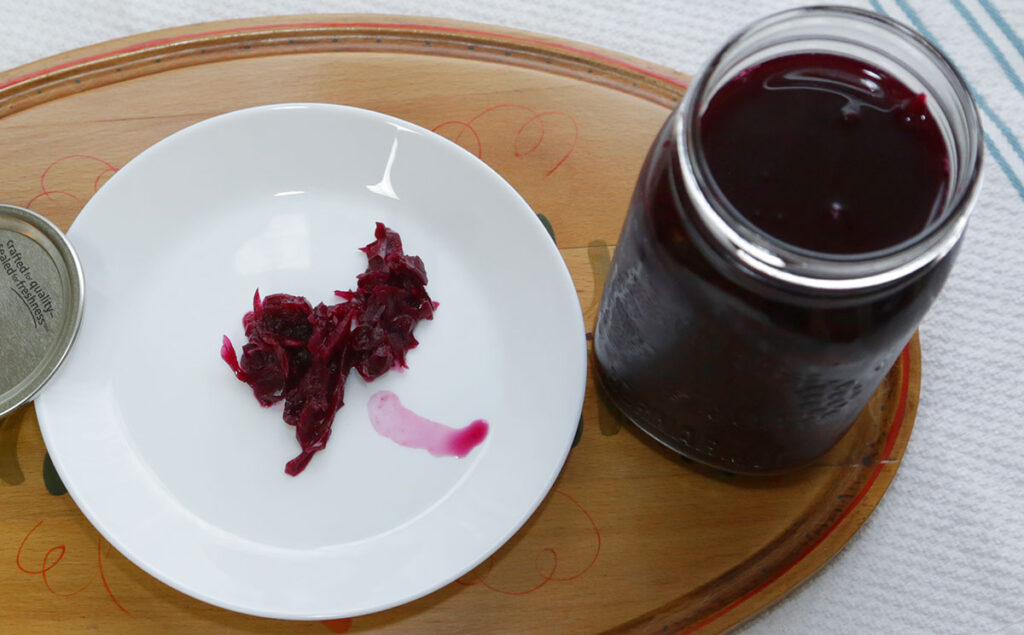
Beets and Red Cabbage Ferment
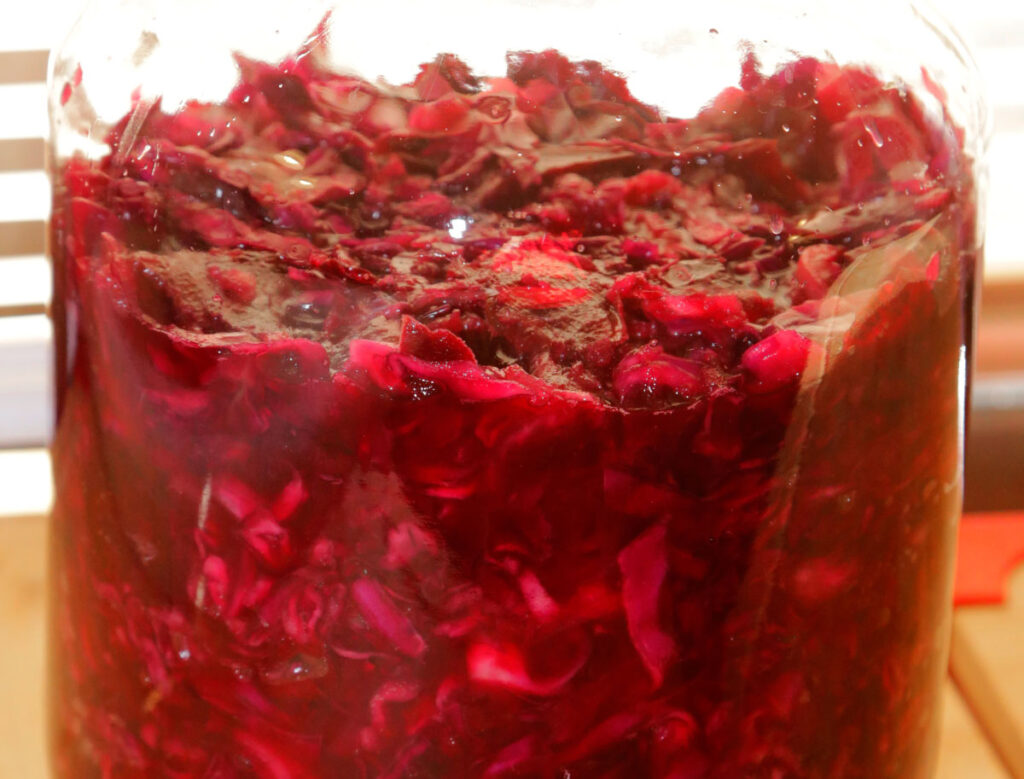
Directions
- This can also be made using only beets and no cabbage. Adjust the amounts accordingly.
- 1 head of Red Cabbage, sliced
- 4 Red Beets peeled and thinly sliced. If beets are grated, they become somewhat slimy in a ferment. Still good, just a different mouthfeel.
- 2 tablespoons pink Himalayan sea salt (or pickling salt – no iodine in salt)
- 1/2 cup honey
- 2 Red onions thinly sliced
- 3 medium to large size apples – peeled and grated
- 1 fresh knob of Ginger, peel it, grate it, squeeze, and use the juice only. (optional) If you have ever heard of Ginger Bug, it is fermented Ginger, and sometimes I add a little of this. It helps speed up the fermentation process.
- Follow the rest of the directions given for the beta-carotene-rich Fermented Sweet Potato Blend.
Sweet Sauerkraut
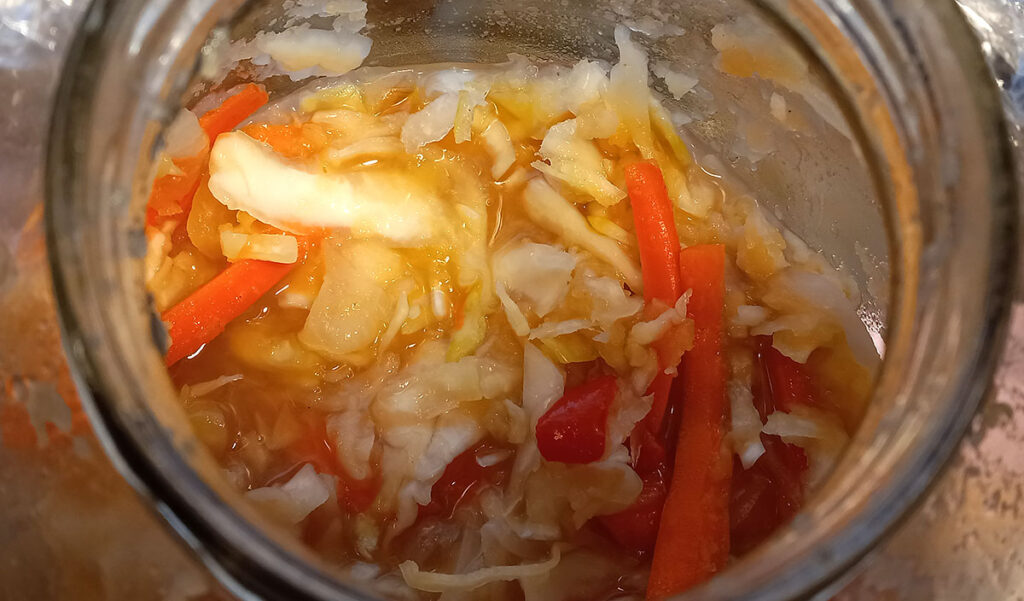
Directions
- 1 head of White Cabbage, sliced thinly
- 4 large carrots – peeled and julienned (these stay crunchy, and you will want lots in your sweet sauerkraut)
- 2 white onions thinly sliced (medium size – sweet)
- 4 Sweet Red Peppers seeded and thinly sliced
- 3 medium to large size apples – peeled and grated
- 2 tablespoons pink Himalayan sea salt (or pickling salt – no iodine in salt)
- 1/2 cup honey
- 1 fresh knob of Ginger, peel it, grate it, squeeze, and use the juice only. (optional)
- 1/2 teaspoon of dry Coriander (optional)
- 1/8th teaspoon Cayenne Pepper (Optional) adds some heat.
- Follow the rest of the directions given for the beta-carotene-rich Fermented Sweet Potato Blend.
Love the taste and the health benefits!
